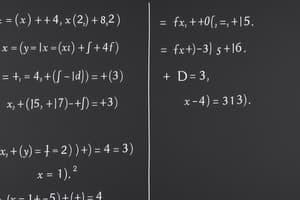Podcast
Questions and Answers
What is the domain of the function in Card 1?
What is the domain of the function in Card 1?
- x ≥ 0
- x = -5
- -7 ≤ x < 5 (correct)
- -4 ≤ x ≤ 4
What is the range of the function in Card 2?
What is the range of the function in Card 2?
-2 < y < 6
The function in Card 3 is a function.
The function in Card 3 is a function.
False (B)
What is the range of the function in Card 4?
What is the range of the function in Card 4?
The function in Card 5 has a domain of x > 0.
The function in Card 5 has a domain of x > 0.
What is the range of the function in Card 6?
What is the range of the function in Card 6?
What is the domain of the function in Card 7?
What is the domain of the function in Card 7?
What is the range of the function in Card 8?
What is the range of the function in Card 8?
The function in Card 9 is a function.
The function in Card 9 is a function.
What is the domain of the function in Card 10?
What is the domain of the function in Card 10?
Study Notes
Domain and Range Overview
- Understanding domain and range is crucial for determining the characteristics of functions in graphs.
- The domain refers to the set of possible x-values, while the range refers to the set of possible y-values.
Domain and Range Examples
-
Card 1
Domain: -7 ≤ x < 5
Range: -3 ≤ y < 1
Indicates a valid function as it passes the vertical line test. -
Card 2
Domain: x = -5
Range: -2 < y < 6
Invalid function since all x-values are the same (not a function). -
Card 3
Domain: -4 ≤ x ≤ 4
Range: -4 ≤ y ≤ 4
Not classified as a function because multiple y-values correspond to a single x-value. -
Card 4
Domain: x ≥ 0
Range: All Real Numbers
This does not form a function; it has vertical line overlaps. -
Card 5
Domain: x > 0
Range: y = 4
Valid function, as there is a consistent y-value for all x-values in the domain. -
Card 6
Domain: -3 < x ≤ 5
Range: y = -1
It represents a valid function with a single y-value across the defined domain. -
Card 7
Domain: -4 ≤ x ≤ 2
Range: -2 ≤ y ≤ 4
This is a proper function indicating a one-to-one relationship within the specified range. -
Card 8
Domain: -3 < x < 4
Range: 0 ≤ y < 5
It qualifies as a function with bounded output values. -
Card 9
Domain: -3 ≤ x ≤ 4
Range: -2 ≤ y ≤ 4
Non-function due to multiple y-values being linked to specific x-values. -
Card 10
Domain: All Real Numbers
Range: y ≥ 0
Defines a valid function with a horizontal asymptote at y = 0.
Function Criteria
- A function must have only one output (y-value) for each input (x-value) to be valid.
- Graphically, a vertical line drawn through any part of the graph should intersect it at no more than one point.
Studying That Suits You
Use AI to generate personalized quizzes and flashcards to suit your learning preferences.
Description
This quiz explores the concepts of domain and range essential for analyzing functions in graphs. Through various examples, it identifies valid and invalid functions based on x and y values. Test your understanding of these crucial concepts and determine the characteristics of different functions.




